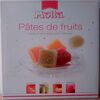E140 - Chlorophylls and Chlorophyllins
Contains:
Functions: Colour
Chlorophyll d is a form of chlorophyll, identified by Harold Strain and Winston Manning in 1943. It is present in cyanobacteria which use energy captured from sunlight for photosynthesis. Chlorophyll d absorbs far-red light, at 710 nm wavelength, just outside the optical range. An organism that contains chlorophyll d is adapted to an environment such as moderately deep water, where it can use far red light for photosynthesis, although there is not a lot of visible light. - Wikipedia
EFSA evaluation: Scientific Opinion on the re-evaluation of chlorophylls -E 140i- as food additives (2015-05-07)
639 products
-
Sauce apéritif Guacamole - Old el paso - 320gr

-
Chupa chups flavored lollipops - 12g

-
Carte D'or Glace Crème Glacée Menthe 900ml - 491 g

-
Délice pistache amande - Lindt - 150 g

-
Thai green curry paste - 170 g

-
Danette saveur pistache 125 g x 4 - Danone - 0.5 kg

-
Sauce apéritif guacamole doux - Old El Paso - 320 g

-
Krema - 360 g

-
Guacamole - U - 300 g

-
Haribo World Mix - 500g

-
Hollywood Classic Chlorophylle parfum Menthe Verte - 31g

-
Twister mini - 6x300ml

-
Craboo yogurt vanilla - Pilos

-
Chewing-gum Chlorophylle parfum Menthe Verte - Hollywood - 155 g (5 x 31 g)

-
Vitamines C&E DETOX - Monoprix - 1 L

-
Fruchtkaubonbon-Mix - sweet corner - 400 g

-
HARIBO world mix - 120 g

-
Helado pistacho - Valsoia

-
Infusion En Gelée A L'aloé Vera - Sante Nat - 510 g

-
Hacendado - 100 g
-
Rowntrees Randoms Pouch 150G - 150 g

-
Gelatina multifrutas - Dia - 6 x 100 g

-
Twister Pineapple - Glace-Bolaget - 80 ml, 71 g

-
Nüsse - Erdnüsse Wasabi Style - Rewe Beste Wahl - 150g

-
Fruit winders doubles - apple, pear & strawberry - Kellogg's

-
Ricola Menthol - 50 g

-
Kids Mix Eis
-
Donuts fraise simpson - THE SIMPSONS - 4 x 42 g

-
Thai Green Curry Paste - Blue dragon - 285g

-
Darkmilk giant buttons

-
Menta choco trozos - Hacendado

-
Mélange Japonais - daco bello - 250g

-
Citrus Mix - Halls - 32 g

-
Savora - 250g

-
Citrus mix - Halls

-
Rigola eucalyptus - Ricola - 50 g

-
Vermicelles multicolores - Chabrior - 60 g

-
Multifruit Lollies - Emotionals - 135 g

-
Goms - La pie qui chante - 140 g

-
Wasabi peas - By Sainsbury's

-
Menthol - Bonbons aux plantes suisses - Ricola - 52,5 g

-
Eucalyptus - Ricola - 52.5 g

-
CARTE D OR - 657 g

-
La dynamique pomme kiwi concombre - Picard - 275 g

-
Sparkling Marshmallow - 3

-
Ifri - 1 l

-
Crunchips Cream and Mild Wasabi - Lorenz - 110 g

-
Guacamole style - Old El Paso - 320g

-
Pastilles pour la gorge Cassis - Migros - 110 g

-
Donut pink glazed - The Simpsons - 228 g e

-
Zest'Fou - Confiseries aromatisées - kréma - 580 g

-
Croq'andise - La pie qui chante - 360 g

-
Summer Mix - Langnese - 10 x 644 ml

-
The Simpsons Donuts - - 228g

-
Eucalyptus - Ricola - 50 g

-
Mini Calippo Orange & Lemon-Lime - Walls - 480 ml

-
Assortiment royal - La pie qui chante - 350 g

-
Mélange japonais 175 g - Paquito

-
Bonbons gommes saveurs fruitées - U - 300 g

-
Bâtonnets fraîcheur façon virgin mojito - Mucci - 378 g

-
Liégeois Saveur Pistache - pâturages - 4x100g

-
Pâtes de fruits - Motta - 250 g

-
Fantasmikos helados con sabores variados a frutas sin gluten - Nestlé - 240g
-
Halls Sugar Free Mild Spearmint Candy - 2 x 32 g

-
Couronne des rois fruits confits - Brioche Pasquier

-
Actimel protect - Danon - 95 ml

-
Asiatische Reiscracker mit Erdnüssen Tokio Mix - Meienburg - 200 g

-
Mostaza - savora - 500 g

-
Erdnuss Asia Style - Gut & Günstig - 200 g

-
Mélange japonais - Daco Bello - 300 g

-
Mostaza - Menoyo - 250 g

-
Slippery fingers - Langnese - 2pcs

-
Pistachio delight with almond pieces - Lindt - 150g

-
Rodeo Sour - Popandsweet

-
Pates de fruits - Motta

-
Untable Neufchatel light - tregar - 190g

-
Wasabi Peanuts - Enso

-
Le Coeur Frais Guacamole - Fleury Michon - 224 g

-
Carte D'or Les Authentiques Glace Menthe Eclats de Chocolat Noir - 1 l (500 g)

-
Ricola 50g s/s menthol offre éco

-
Ifri Pomme verte - 1,25 l

-
Sauce Tartare - Regalo
-
Eucalyptus Kräuterbonbons - Ricola - 50g

-
Sorbet Plein de Fruit Citron Vert - Carte D'or - 585 g

-
Mélange japonais - Apéros du Vieux Bistrot - 160 g

-
Krema festival - 580 g

-
Mix de bonbons - Les Doodingues - 600 g

-
Carte D'or Les Authentiques Glace Menthe Chocolat 1.4l - 700 g

-
Bonbons à l'Ancienne - Old Dutch Classic Mix - Hema - 150 g

-
Finley Citron & Fleur de sureau - 250 ml

-
C. or Bac Sorbet Citr Vert - carte d'or - 650 g

-
Creation macaron pistache - Lindt - 150g

-
Sorbet pomme - U - 540 g

-
Doux secrets - Crème dessert saveur pistache - Le Fromager Des Halles - 500 g (4X1

-
Mélange japonais - 0,300 kg

-
Ricola 50g s/s alpin fresh new

-
Rice Crackers Japonais Impérial - Bedros & Savino - 300 g

-
Pastilles Cassis - Dr. Watson's - 110g

-
Hiker's mint XL spearmint - 40g

-
krema festival - carambars - 590

